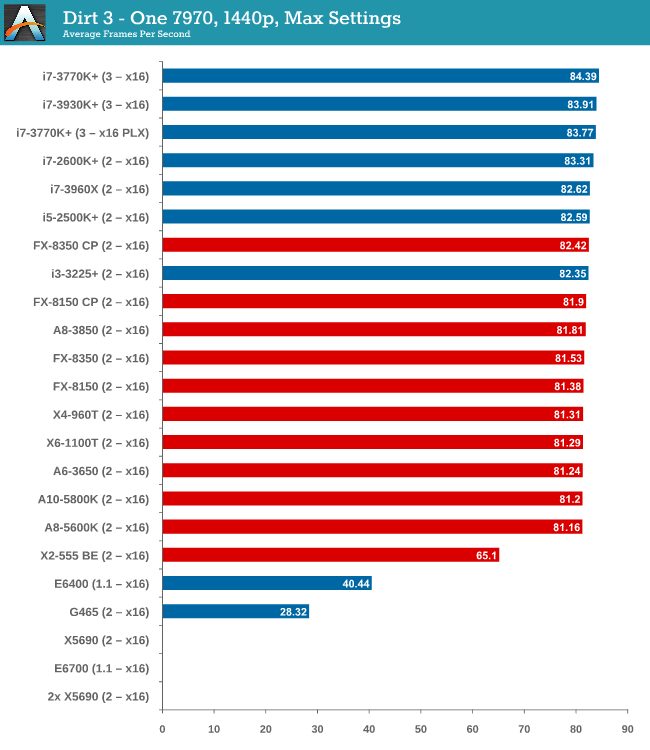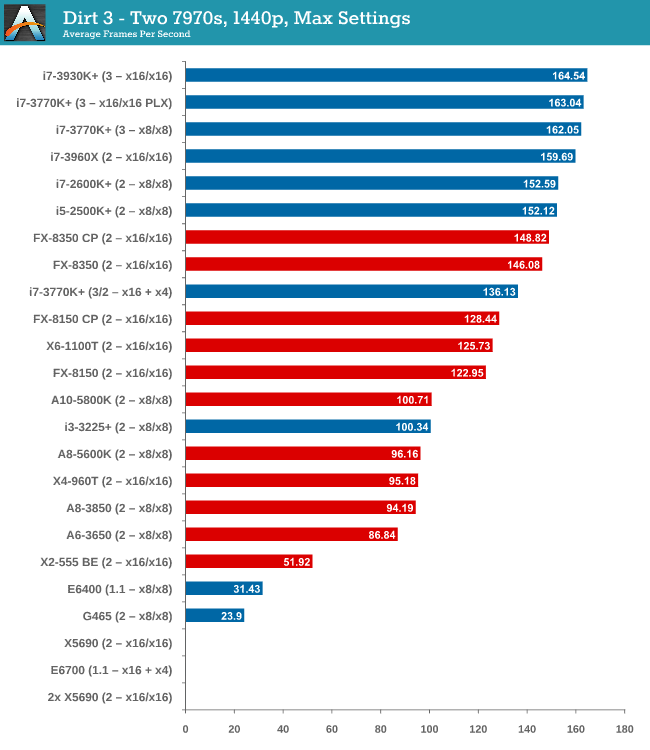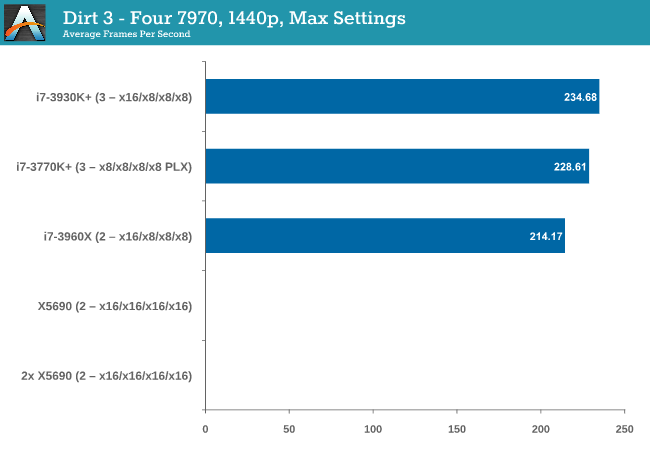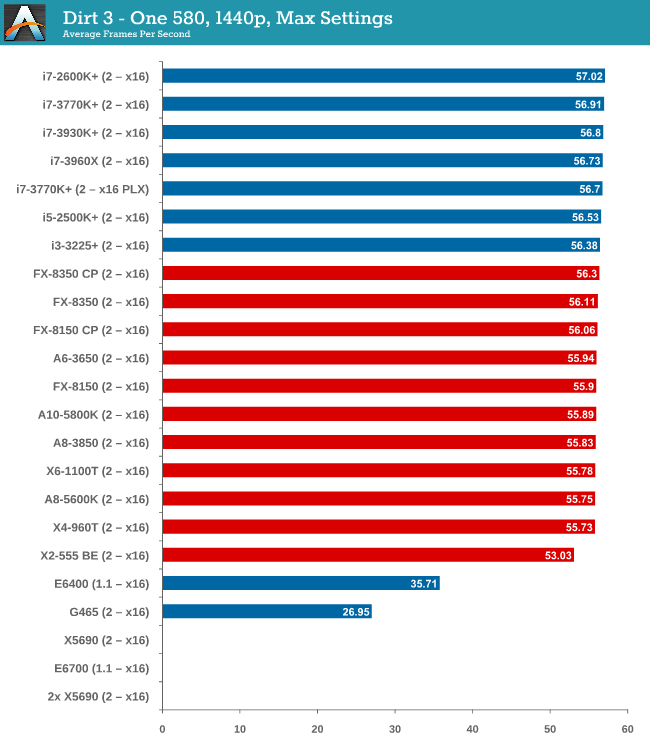Choosing a Gaming CPU: Single + Multi-GPU at 1440p, April 2013
by Ian Cutress on May 8, 2013 10:00 AM ESTDiRT 3
DiRT 3 is a rallying video game and the third in the Dirt series of the Colin McRae Rally series, developed and published by Codemasters. DiRT 3 also falls under the list of ‘games with a handy benchmark mode’. In previous testing, DiRT 3 has always seemed to love cores, memory, GPUs, PCIe lane bandwidth, everything. The small issue with DiRT 3 is that depending on the benchmark mode tested, the benchmark launcher is not indicative of game play per se, citing numbers higher than actually observed. Despite this, the benchmark mode also includes an element of uncertainty, by actually driving a race, rather than a predetermined sequence of events such as Metro 2033. This in essence should make the benchmark more variable, but we take repeated runs in order to smooth this out. Using the benchmark mode, DiRT 3 is run at 1440p with Ultra graphical settings. Results are reported as the average frame rate across four runs.
One 7970

While the testing shows a pretty dynamic split between Intel and AMD at around the 82 FPS mark, all processors are roughly +/- 1 or 2 around this mark, meaning that even an A8-5600K will feel like the i7-3770K.
Two 7970s

When reaching two GPUs, the Intel/AMD split is getting larger. The FX-8350 puts up a good fight against the i5-2500K and i7-2600K, but the top i7-3770K offers almost 20 FPS more and 40 more than either the X6-1100T or FX-8150.
Three 7970s

Moving up to three GPUs and DiRT 3 is jumping on the PCIe bandwagon, enjoying bandwidth and cores as much as possible. Despite this, the gap to the best AMD processor is growing – almost 70 FPS between the FX-8350 and the i7-3770K.
Four 7970s

At four GPUs, bandwidth wins out, and the PLX effect on the UP7 seems to cause a small dip compared to the native lane allocation on the RIVE (there could also be some influence due to 6 cores over 4).
One 580

Similar to the one 7970 setup, using one GTX 580 has a split between AMD and Intel that is quite noticeable. Despite the split, all the CPUs perform within 1.3 FPS, meaning no big difference.
Two 580s

Moving to dual GTX 580s, and while the split gets bigger, processors like the i3-3225 are starting to lag behind. The difference between the best AMD and best Intel processor is only 2 FPS though, nothing to write home about.
DiRT 3 conclusion
Much like Metro 2033, DiRT 3 has a GPU barrier and until you hit that mark, the choice of CPU makes no real difference at all. In this case, at two-way 7970s, choosing a quad core Intel processor does the business over the FX-8350 by a noticeable gap that continues to grow as more GPUs are added, (assuming you want more than 120 FPS).










242 Comments
View All Comments
HisDivineOrder - Thursday, May 9, 2013 - link
Shhhhhh. You're using too much of that stuff called sense. It might spread and suddenly everyone would want case reviews that reflect what anyone who'd install a motherboard in 99% of the cases they review instead of miniITX for every review. I mean, there's no way that putting a miniITX or microATX into every case review isn't going to impact the actual case being reviewed, is there?IS THERE?
crimson117 - Thursday, May 9, 2013 - link
Agreed - why review a full tower with a micro atx? Who builds like that?Gigaplex - Sunday, May 12, 2013 - link
I do. Is that a problem?Blibbax - Wednesday, May 8, 2013 - link
If you're recommending the A8-5600K, but for people with a discrete GPU, aren't you really recommending the FX-4*** series?Ortanon - Wednesday, May 8, 2013 - link
Excellent question.IanCutress - Wednesday, May 8, 2013 - link
Good point - apart from not testing the FX-4xxx processors (I don't have any), the FX-4xxx uses an AM3 platform - the FM2 platform is both newer and the chipsets offer more native USB 3.0 / SATA 6 Gbps as well as a UEFI BIOS from the ground up. The FX-4xxx is still a relevant choice with its L3 cache, and a couple of newer boards have been released to try and get the best from the 990FX chipset. Though out of what I have tested so far, the A8 makes the most sense if you're looking at pure 1-GPU gaming. If I get an FX-4100 in, it will be tested and conclusions adjusted if it performs similarly - there's no point suggesting a CPU I haven't tested and can't back it up with data.Ian
Blibbax - Wednesday, May 8, 2013 - link
I entirely agree that it'd be wrong to make conclusions without data. However, I feel like the APU recommendation ought to go with some sort of "however..." caveat.I look forward to your FX4 and FX6 results, however. I was initially not at all sold on these chips, but now that the prices have come down and the FX6 is often priced against Intel's i3, they are much more compelling.
DeathReborn - Wednesday, May 8, 2013 - link
There's always the Athlon II X4 750K BE which still uses FM2 but lacks the IGP.Cow86 - Wednesday, May 8, 2013 - link
If you're going to compare it against Trinity APU's, then wouldn't it be fairer to get an FX-4300, based on the same piledriver core? See if that L3 cache makes enough of a difference? More up to date as well...kmmatney - Wednesday, May 8, 2013 - link
If you live near a microcenter, you can get an FX-4130 (3.8 Ghz) and motherboard for $99. That leaves quite of room to get a better GPU, and probably a better overall gaming experience for a given amount of money. I upgraded from an X4-955 to a 3570K about 6 months ago, and have to admit that I barely notice the performance increase in games, and would have probably been better off spending the $250 on a better video card. I do like the extra speed while using handbrake, though, and my son likes my old X4-955 that was a big upgrade from his previous setup, though.